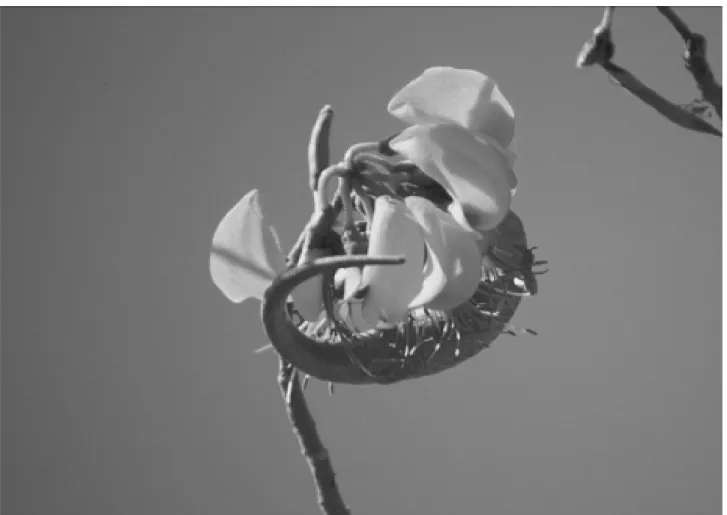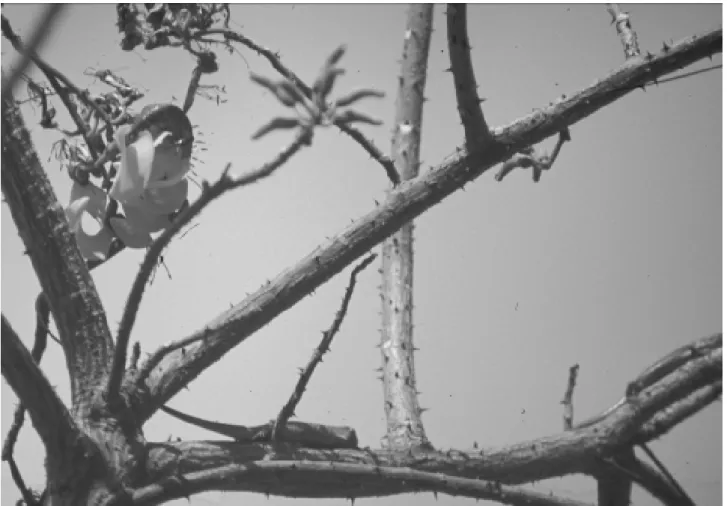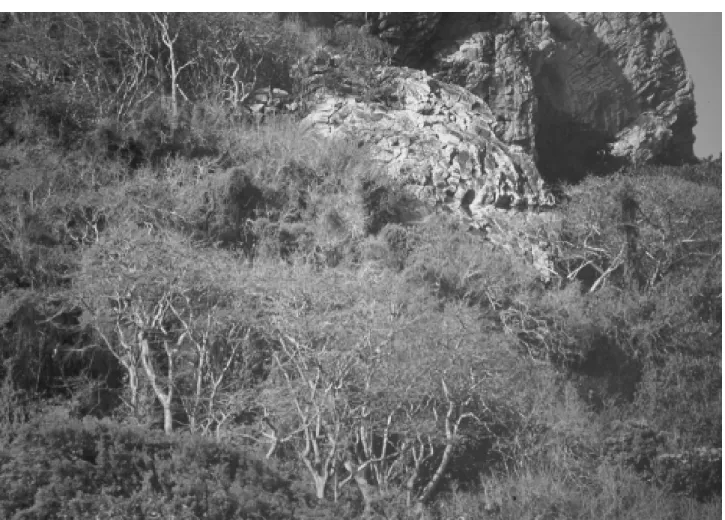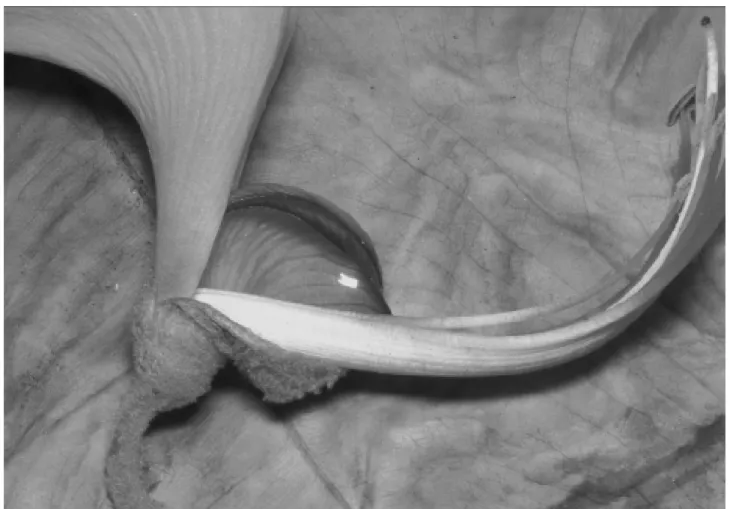LITTLE DRAGONS PREFER FLOWERS TO MAIDENS: A LIZARD THAT
LAPS NECTAR AND POLLINATES TREES
*Departamento de Zoologia e Museu de História Natural, Caixa Postal 6109, Universidade Estadual de Campinas, 13083-970 Campinas, São Paulo, Brazil (www.unicamp.br)
Corresponding author. Tel: + 55-19-3788 7292; fax: +55-19-3289 3124; e-mail: isazima@unicamp.br
**Departamento de Zoologia, Caixa Postal 199, Universidade Estadual Paulista, 13506-900 Rio Claro, São Paulo, Brazil ***Departamento de Botânica, Caixa Postal 6109, Universidade Estadual de Campinas, 13083-970 Campinas, São Paulo, Brazil
Abstract
Lizards rarely visitand pollinate flowers, the few recent records being mostly restricted to island habitats. We report here on the Noronha skink (Euprepis atlanticus) seeking nectar in the flowers of the leguminous mulungu tree (Erythrina velutina) at Fernando de Noronha Archipelago, off northeast Brazil. The mulungu tree blooms during the dry season, and each flower secretes copious and diluted nectar throughout the day. The Noronha skink climbs up to the inflorescences and laps the nectar accumulated in the flowers’ base. While exploiting the flowers and crawling over the inflorescences, the body parts of the skink contact the anthers and stigmas and pollen adheres to the lizard’s scales. The lizard visits inflores-cences from the same and different trees, which renders it a potential pollinator. As the mulungu tree blooms during the dry season and the island has little or no natural freshwater supply during drought periods, we suggest that the Noronha skink seeks flower nectar both for its energetic, diluted sugars and the water content.
Key words: Euprepis atlanticus, Scincidae, Erythrina velutina, Fabaceae, saurophily, oceanic islands.
Resumo
Lagartos raramente visitam e polinizam flores, os poucos registros estando restritos a ambientes insulares. Registramos aqui a mabuia de Noronha (Euprepis atlanticus) buscando néctar nas flores da árvore leguminosa mulungu (Erythrina velutina), no Arquipélago de Fernando de Noronha ao largo da costa Nordeste do Brasil. O mulungu floresce na época seca, ao longo de quatro meses. As flores produzem néctar muito diluído e abundante, ao longo do dia todo. A mabuia percorre as inflorescências, lambendo o néctar acumulado na base da flor. Enquanto rasteja sobre as inflorescências da mesma ou outra árvore, contata as anteras e os estigmas e o pólen fica aderido ao seu corpo, o que torna a mabuia um polinizador potencial. Como o mulungu floresce durante a época seca, período em que a água é muito escassa na ilha, sugerimos que a mabuia visita as flores tanto pelos açúcares diluídos e energéticos, como pela água contida no néctar.
Palavras-chave: Euprepis atlanticus, Scincidae, Erythrina velutina, Fabaceae, saurofilia, ilhas oceânicas.
Biota Neotropica v5(n1) – http://www.biotaneotropica.org.br/v5n1/pt/abstract?short-communication+BN00805012005
Ivan Sazima*, Cristina Sazima*,**, Marlies Sazima***
Recebido: 12/09/2004 Revisado: 12/11/2004
Sazima, I.; Sazima, C. and Sazima, M. - Biota Neotropica, v5 (n1) - BN00805012005
1. Introduction
Lizards are among the least expected vertebrate polli-nators and we can hardly speak of saurophily – a syndrome that would encompass flower features suited to pollination by reptiles – or coevolved systems (but see Olsson et al. 2000). Nevertheless, there are several recent records of liz-ards that visit and supposedly or actually pollinate flowers, including species of Gekkonidae, Lacertidae, Polychrotidae, Scincidae, and Teiidae (e.g., Dearing 1993, Eifler 1995, Elv-ers 1977, Font & Ferrer 1995, Pérez-Mellado & Casas 1997, Perry & Lazell 1997, Traveset & Sáez 1997, Nyhagen et al. 2001, Olesen & Valido 2003). Most if not all records of flower-visiting lizards are in islands, ranging in size from the Nitge islet in the Mediterranean (Pérez-Mellado & Casas 1997) to Tasmania in the Pacific (Olsson et al. 2000). A recent review (Olesen & Valido 2003) stresses that lizard pollination is an island phenomenon. Not surprisingly lizards seek nectar mostly on inflorescences – an arrangement well suited for a climbing visitor (see Westerkamp 1990 for a discussion on flowers visited by perching and hovering birds).
The Noronha skink Euprepis atlanticus (= Mabuya atlantica), a lizard endemic to Fernando de Noronha Archi-pelago in SW Atlantic (Mausfeld et al. 2002), attains up to 25 cm in total length, forages mostly on the ground and thrives on anything edible from human leftovers to its own eggs (Silva-Jr. et al. 2005). This ‘little dragon’ is even able to tear apart pieces from larger animals’ corpses (birds and fishes, IS pers. obs.). We report here on the Noronha skink’s visits to flowers of the leguminous mulungu tree Erythrina velutina (Fabaceae) which blooms during the dry season. As the island has little or no natural freshwater supply dur-ing this period, we suggest that the skink takes the nectar both for its energetic sugars and the water content.
2. Material and Methods
Field observations were conducted at several sites from the sea level to about 50 m a.s.l. on the main island of Fernando de Noronha Archipelago (03°50’S, 32°15’W), off northeast Brazil (see Carleton & Olson 1999 for map and description). The visits of the skinks to mulungu tree flow-ers were recorded and documented in October 2002 and 2004, and November 2003. We observed the lizards in a total of seven individual trees 3-18 m tall. During observational sessions of 20-50 min (totalling 11 h) we used ‘focal animal’ sampling in which all occurrences of specified actions were
mulungu tree, to examine pollen placement on their body after visits to the flowers. We recorded flower biology fea-tures including time and period of anthesis (see Faegri & van der Pijl 1980), receptivity of stigmas being tested with H202–catalase activity (Zeisler 1938). Nectar concentration and volume were taken in early morning from 22 flowers bagged in previous late afternoon, and measured with a portable refractometer and a microlitre syringe respectively.
3. Results
The Noronha skink (Euprepis atlanticus) climbed up to about 12 m to reach the flowers of the mulungu tree (Erythrina velutina), and visited the plants throughout the day. On reaching an inflorescence, the skink inserted its head into a flower and lapped the nectar accumulated at the flower’s base. The exploitation of a given flower was done in 2-4 lapping bouts, each of them lasting 3-5 sec. Each open flower in an inflorescence was examined and probed for nectar. While seeking for nectar the Noronha skink crawled over the inflorescences and its body parts (head, back, belly, limbs) contacted the anthers and stigma (Fig. 1). Visits to each inflorescence lasted 40-201 sec (mean= 77.33, SD±50.75, N= 12), this variation partly due to flower number (e.g., one skink stayed on an inflorescence with seven flow-ers for 155 sec). However, the skinks lingered on the inflo-rescences between the nectar-lapping bouts, and also on the branches between visits to different inflorescences (probably a thermoregulatory behaviour), which added to visitation period variation. The skinks moved from flower to flower on the same inflorescence, from one inflorescence to another, and between neighbour trees. One closely followed skink visited three small trees (height 2-3 m) in a row. Two to three skinks exploited the same tree at the same time (Fig. 2), the larger individuals chasing and/or dislodging the smaller ones from an inflorescence or a flower-bearing branch. Be-tween nectar-drinking bouts, the skinks foraged on the ground for insects and other foods. After a day in the box along with the inflorescences, the two skinks had patches of pollen over their body (mostly on belly and chin), and there was pollen adhered on the flowers’ stigmas.
Sazima, I.; Sazima, C. and Sazima, M. - Biota Neotropica, v5 (n1) - BN00805012005
Sazima, I.; Sazima, C. and Sazima, M. - Biota Neotropica, v5 (n1) - BN00805012005
open ones per day (mean= 4.23, SD±1.81, N= 26). Nectar is diluted (10.5-13%), copious (Fig. 4), and available on flower opening. A single flower may accumulate up to 106 µl of nectar in 55 min. Each flower produces nectar continuously for one day, although its stigma remains receptive for two days. The yellow pollen (Fig. 4) adheres easily even to smooth and dry surfaces such as the Noronha skink scales.
4. Discussion
The nectar-seeking behaviour of the Noronha skink is similar to that recorded for other flower-visiting lizards, except for the skinks climbing on trees, not shrubs and herbs as recorded in most studies on nectar seeking lizards (e.g., Eifler 1995, Elvers 1977, Font & Ferrer 1995, Perry & Lazell 1997, Traveset & Sáez 1997, but see Nyhagen et al. 2002 for Phelsuma geckos). Tree climbing for the Noronha skink would not be surprising, however, since several skink spe-cies are arboreal (Pianka & Vitt 2003), and in spite of its predominantly ground-dwelling habits Euprepis atlanticus is a skilled climber (IS pers. obs.). Moreover, the little dragon of Noronha is a very versatile and opportunistic forager (Silva-Jr et al. 2005), and food resources on islands may be scarce for lizards (e.g., Pérez-Mellado & Casas 1997, Olesen & Valido 2003).
Although we did not examine closely the pollinating role (see Pérez-Mellado & Casas 1997, Traveset & Sáez 1997) of E. atlanticus, the pollen stuck on its scales throughout its wandering between the flowers and its bodily contact with the flowers’ anthers and stigmas favours the view that the skink is a pollinating agent of Erythrina velutina. As the skinks visited neighbour trees, their activity likely favours cross-pollination and enhances the genetic variability (Webb & Bawa 1983) of the mulungu tree.
Erythrina velutina produces nectar much less con-centrated and in much larger amounts than two other spe-cies within the genus studied in Brazil. For E. speciosa the concentration is about 38% and the volume is about 15µl (Buzato et al. 2000), and for E. dominguezii these values are about 20% and 65µl (Ragusa-Netto 2002). Blooming at the dry season is a trend for species of Erythrina in Brazil (Lorenzi 1992, Buzato et al. 2000, Ragusa-Netto 2002), but in the island habitat of Fernando de Noronha Archipelago, with little or no natural freshwater supply during drought, this trend seems much providential (see below). The impor-tance of E. dominguezii nectar as food supply for birds during the fruit-short dry season was commented upon by Ragusa-Netto (2002).
Since the Noronha skink is not too much pressed by lack of food, as it is able to capitalize on almost anything edible (Silva-Jr et al. 2005, our pers. obs.), the diluted mulungu nectar may be regarded as a bonus in its daily feeding schedule. On islands, lizards tend to reach high
population density and experience low predation risk, and thus may expand their diet to include nectar, pollen, and fruits (Olesen & Valido 2003). At Fernando de Noronha Ar-chipelago, Euprepis atlanticus has high population densi-ties and is preyed on by introduced vertebrates only (Silva-Jr. et al. 2005), which lends support to the above mentioned view (Olesen & Valido 2003). An additional support to our assumption that the Noronha skink visits flowers for both sugars and water may be the fact that most if not all in-stances of flower-visiting and nectar-lapping lizards are re-corded from oceanic islands (Olesen & Valido 2003), mainly in relatively arid environments (e.g., Eifler 1995, Elvers 1977, Font & Ferrer 1995, Pérez-Mellado & Casas 1997, Perry & Lazell 1997, Traveset & Sáez 1997). The midsummer diet of the lacertid Podarcis lilfordi on Nitge islet is composed mostly of nectar (Pérez-Mellado & Casas 1997), a further support to our view that versatile, insular lizards may be seeking flowers for water supply besides sugars.
Taken together, the Noronha skinks’ day-round flower visitation, the mulungu trees blooming during the dry sea-son, the large amount of diluted nectar, and the lack or scar-city of natural freshwater sources on the island, strongly indicate that the skinks seek nectar both for sugar and wa-ter intake. Even for lizards that dwell in xeric environments water intake is done by active drinking (Zug et al. 2001, Pianka & Vitt 2003), and we may add dilute nectar intake for water balance as well (present paper). We strongly suspect that lizards’ visits to flowers serve a dual purpose: energy acquisition (Olesen & Valido 2003) and water balance, al-though this latter role of nectar in the physiology of flower-visiting lizards remains open to investigation.
5. Acknowledgements.
We thank J. M. Silva-Jr. (Centro Golfinho Rotador) for a constant and friendly helping hand; M.A. Silva (Ibama) for the warm reception and permission to study vertebrates at the Marine National Park of Fernando de Noronha; the FAEP-Unicamp, and FAPESP for essential financial support. The authors are recipients of scholarships from the CNPq-Brasil. Two anonymous referees improved the paper.
6. References
ALTMANN, J. 1974. Observational study of behavior: sam-pling methods. Behaviour 49: 227-265.
BUZATO, S., SAZIMA, M. & SAZIMA, I. 2000. Humming-bird-pollinated floras at three Atlantic forest sites. Biotropica 32: 824-841.
Sazima, I.; Sazima, C. and Sazima, M. - Biota Neotropica, v5 (n1) - BN00805012005
DEARING, M. D. 1993. An alimentary specialization for her-bivory in the tropical whiptail lizard Cnemidophorus murinus. J. Herpetol. 27: 111-114.
EIFLER, D. A. 1995. Patterns of plant visitation by nectar-feeding lizards. Oecologia 101: 228-233.
ELVERS, I. 1977. Flower-visiting lizards on Madeira. Bot. Notiser 13: 231-234.
FAEGRI, K. & van der PIJL, L. 1980. The principles of polli-nation ecology. Pergamon Press, Oxford.
FONT, E. & FERRER, M. J. 1995. Gallotia galloti (Canary Islands lizard). Nectar feeding. Herp. Rev. 26: 35-36. LORENZI, H. 1992. Árvores brasileiras: manual de
identificação e cultivo de plantas arbóreas nativas do Brasil. Ed. Plantarum, Nova Odessa.
MAUSFELD, P., SCHMITZ, A., MISOF, B., VRCIBRADIC, D. & ROCHA, C. D. 2002. Phylogenetic affinities of Mabuya atlantica Schmidt, 1945, endemic to the Atlan-tic Ocean Archipelago of Fernando de Noronha (Brazil): necessity of partitioning the genus Mabuya Fitzinger, 1826 (Scincidae: Lygosominae). Zool. Anz. 241: 281-293. NYHAGEN, D.F., KRAGELUND, C., OLESEN, J. M. & JONES, C. G. 2001. Insular interactions between lizards and flowers: flower visitation by an endemic Mauritian gecko. J. Trop. Ecol. 17: 755-761.
OLESEN, J. M. & VALIDO, A. 2003. Lizards as pollinators and seed dispersers: an island phenomenon. Trends Ecol. Evol. 18: 177-181.
OLSSON, M., SHINE, R. & BA’K-OLSSON, E. 2000. Lizards as a plant’s ‘hired help’: letting pollinators in and seeds out. Biol. J. Linn. Soc. 71: 191-202.
PÉREZ-MELLADO, V. & CASAS, J. L. 1997. Pollination by a lizard on a Mediterranean island. Copeia 1997: 593-595. PERRY, G. & LAZELL, J. 1997. Anolis stratulus (saddled
anole). Nectivory. Herp. Rev. 28: 150-151.
PIANKA, E. R. & VITT, L. J. 2003. Lizards: windows to the evolution of diversity. Univ. California Press, Berkeley. RAGUSA-NETTO, J. 2002. Exploitation of Erythrina
dominguezii Hassl. (Fabaceae) nectar by perching birds in a dry forest in Western Brazil. Braz. J. Biol. 62: 877-883. SILVA-JR., J. M., PÉRES-JR., A. K. & SAZIMA, I. 2005. Euprepis atlanticus (Noronha skink). Predation. Herp. Rev. 36: 62-63.
TRAVESET, A. & SÁEZ, E. 1997. Pollination of Euphorbia
WESTERKAMP, C. 1990. Bird-flowers: hovering versus perching exploitation. Bot. Acta 103: 366-371.
ZEISLER, M. 1938. Über die Abgrenzung der eigentlicher Narbenfläche mit Hilfe von Reaktionen. Beih. Bot. Zentralbl. 58: 308-318.
ZUG, G. R., VITT, L. J. & CALDWELL, J. P. 2001. Herpetol-ogy: an introductory biology of amphibians and rep-tiles. 2nd ed. Academic Press, San Diego.
Title: Little dragons prefer flowers to maidens: a lizard that laps nectar and pollinates trees
Authors: Ivan Sazima, Cristina Sazima, Marlies Sazima



